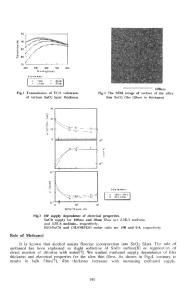Material Properties of Coherent Tin Films
- PDF / 948,721 Bytes
- 6 Pages / 414.72 x 648 pts Page_size
- 16 Downloads / 337 Views
ABSTRACT In this paper, material properties of low pressure, metallic mode Coherent TiN and poison mode Coherent TiN have been examined. The material properties include resistivity, crystal orientation, stress, lattice spacing, density, texture, atomic composition, bonding, roughness, hydrogen content, and grain size. Various analytical tools have been used to analyze the TiN films.
INTRODUCTION For sub-0.5 gm technologies, aluminum deposited or flowed at temperatures exceeding 450'C is a means to achieve planarization. The high temperatures involved place a stringent demand on the integrity of the barrier to prevent junction spiking caused by A1I/Si interdiffusion. TiN is presently considered to be the barrier material of choice for sub-0.5 gm metallization. For contacts with high aspect ratios (> 2:1), the TiN barrier must be deposited using Coherent PVD or CVD. In Coherent PVD TiN technology, a collimator plate is inserted between the wafer and the target. Using a source optimized for manufacturing, a uniform film with enhanced bottom step coverage can be obtained. For planarized Al application, both Coherent PVD TiN [1,2,3,5] or CVD TiN [2,3,4] diffusion barrier technology has been described in the literature. Coherent TiN can be sputtered in the "metallic" mode, where the Ti target is non-nitrided; or in the "poison" mode, where the Ti target is nitrided. The metallic Coherent TiN has a deposition rate of about 3 times that of poison Coherent TiN. In this work, the material properties of TiN films have been analyzed with numerous analytical techniques. The similarities and differences in the material properties of the two types of TiN films will be discussed.
EXPERIMENTAL For most experimental work, 150 mm diameter, thermally oxidized (3 kA thickness) silicon wafers and high resistivity (> 150 ohms/sq) bare silicon wafers (p-type, ) were used. The Coherent TiN was deposited in a PVD chamber (Applied Materials' Endura PVD) with a 5/8 inch hex, 1.75:1 collimator filter. A monolithic Ti target was used. In all cases, the PVD heater temperature was kept at 200'C. The TiN film thickness was measured on five points across the wafer by a step profiler. The TiN film sheet resistance was measured on 49 points across the wafer by a four-point probe. The crystal orientation and lattice spacing of the TiN film were measured by XRD (X-ray Diffraction) technique. XRD analysis was performed using a Siemens D 500 system with Cu radiation. Analysis mode was theta/2 theta, scan taken for 2 theta range from 35-85 degree, step size 0.05 degree and scan time 1 second. The TiN film stress was measured with a laser scan across the wafer. The stress change with respect to heat cycle was measured by placing the wafer on a hot plate; the heating and cooling were carried out with a closed loop temperature control. Nitrogen was used to purge the ambient. The TiN film density was evaluated by a combination of film thickness measurement from
217 Mat. Res. Soc. Symp. Proc. Vol. 391 ©1995 Materials Research Society
alpha step profiling
Data Loading...










